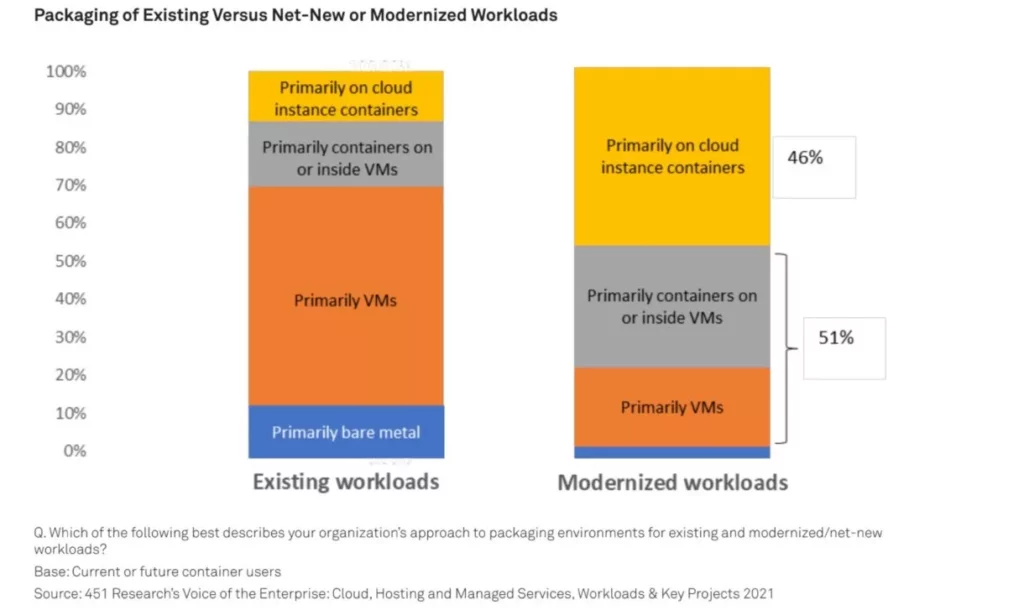Cloud native takes off
Nearly two years since the pandemic began, the conversation about deploying new applications has shifted decisively from concerns over “these challenging economic times” to “cloud-native adoption is going bonkers.” The transition to remote work has driven customer demand and changed the way businesses operate in ways nobody could have predicted. Now, the race is on to bring new applications to market, as fast as possible, and as a result, adoption of cloud-native architectures is currently accelerating at a blistering pace.
But! As surprising and remarkable as 2020 and 2021 cloud adoption has been, all of this begs the question: Are we seeing a temporary cloud boom? Or are we seeing an actual trend in which cloud-native environments will continue to accelerate beyond the pandemic? Even though the jury is still out, some signs are pointing to the latter.
According to a recent 451 Research survey, nearly half of container adopters are deploying net-new and modernized workloads without VMs. However, since VMs are still the primary mode of deployment today – even for net-new and modernized applications – 451 Research cautions we are still watching to see whether cloud-native will take hold more broadly, how long will it take, and what will ultimately shift the balance?
Cloud drivers – faster development, better outcomes
According to 451 Research, part of S&P Global Market Intelligence, enterprises are leveraging cloud capabilities with a goal of achieving faster product development and better customer outcomes. In doing so, they are embracing new approaches, such as:
- Onboarding new modes of development such as DevOps and GitOps.
- Deploying software using cloud-native architectures such as containers and serverless.
- Tapping new sources of data e.g., from edge devices and social media.
Also, as organizations pivoted to support remote working and schooling through the COVID-19 pandemic, many quickly learned to “appreciate the value of ‘virtuality’.” The report cites 451 Research’s Voice of the Enterprise: Cloud, Hosting & Managed Services, Budgets and Outlook 2021 survey, which found:
- 40% of organizations are using more public cloud services due to the pandemic.
- A large portion of organizations expect changes in public cloud usage made during the stay-at-home orders to become permanent.
App modernization investment uptick
According to 451 Research, this shift to the cloud – combined with an explosion in data being collected, stored, and used to inform business decision-making and customer engagement – has resulted in an uptick in app modernization investment. The report supports this statement, citing the research firm’s Voice of the Enterprise: Digital Pulse, Digital Strategy 2021 survey:
- 56% of companies consider digital technology a high strategic priority.
- 46% consider modernizing legacy systems, infrastructure, and applications as a major investment area over the next year.
- Modernization was second only to security (51%) as an investment priority.
- 36% of respondents expect modernization to have a transformational impact on their businesses over the next two to three years.
Containers making inroads
The report notes that a key component of IT modernization is containerization. However, while container adoption is growing, it is not yet universal. 451 Research’s Voice of the Enterprise: Cloud, Hosting and Managed Services, Workloads & Key Projects 2021 survey revealed strong interest in container-usage planning:
- 23% of organizations plan to replace VMs with containers.
- 37% of organizations are using VMs to run containers.
- 35% of organizations using public clouds do not plan to use containers.
Container advantages:
451 Research notes several advantages to using containers:
- Relatively small footprint compared with VMs.
- More efficient resource utilization.
- Enable portable and economical app deployment.
- Kubernetes enables delivery of services across multiple on-premises and off-premises environments, including VMs and bare metal.
Challenges of containers include
Enthusiasm about the promise of Kubernetes and containers has met with difficulty in implementation:
- Extensibility is appealing but creates a multitude of configuration options that must be carefully set and managed.
- Difficulty is compounded when legacy infrastructure and applications need to be brought on board.
- Managing legacy workloads via Kubernetes, and refactoring applications for cloud-native management, both require significant skills and investment.
- Complex for organizations that aren’t born-in-the-cloud.
451 Research emphasizes that VMs are not going away any time soon due to the isolation, security, familiarity, and manageability of VMs. However, seeing strong adoption of modernized workloads may provide insight into where things are heading.





